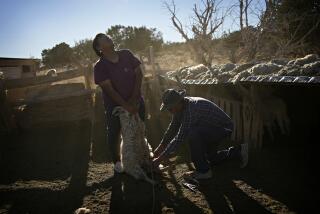Amish country being overrun by 20th Century : Lifestyle of Plain Sect farmers is giving way. High land prices force some to move out.
- Share via
INTERCOURSE, Pa. — In the heart of Amish country, the modern era has finally caught up with the gray-and-black, horse-drawn buggies that still wind their way along the narrow two-lane highways.
Developers have begun to buy large tracts of land and to put up industrial parks, shopping centers and suburban homes--all of which is changing the character of the working landscape and causing the pastoral lifestyle that the Amish and other Plain Sect farmers have known for generations to slip away.
Some of the nation’s most productive agricultural land is now a patchwork quilt of industry, split-level homes and small farms. Land prices have more than doubled in the last eight years, forcing some Amish and Mennonites to give up farming or to leave the area.
“The price of land is so high,” said Stephen Stoltzfus, 48, an Amish carpenter and resident of the Lancaster County town of Compass. “There are only so many farms, and they are getting smaller and smaller. The people who really want to farm only have one choice--to move out.”
About 3 million tourists pass through the county annually, stopping in villages like Intercourse, population 600, to buy antiques, little dolls, quilts, fudge, and hot buttered pretzels.
The town has no police force or traffic lights, but it, too, is feeling the effects of development. A 100-home suburban development has gone up on one former farm. Another development on a 35-acre farm was abandoned only after several angry battles in town meetings led to rezoning the land to primarily agricultural use.
Meat market owner Amos Lantz, 69, agrees with those who say that Intercourse is growing too quickly and becoming too commercial. “I wish they would leave it as it is,” he said.
A similar battle about development is being waged in the picturesque Mill Creek Valley, where some of the richest farmland in the country is owned by some of the oldest Amish and Mennonite families. There, a 114-acre farm is on its way to becoming a 600-unit retirement development--and the site of a new sewage treatment facility.
About 130,000 Amish live in the United States, including 16,000 in Lancaster County. About 5,000 acres of the county’s 400,000 acres of farmland are lost annually to new development, according to city and environmental experts.
The Amish, named for Jacob Ammann, broke away from Swiss Mennonites in a religious dispute 300 years ago and began immigrating here in 1728.
Anabaptists who believe in adult baptism and living apart from the world, they prefer a simple, agrarian lifestyle. They are pacifists and do not swear oaths or hold public office. Families have an average of seven children. Old Order Amish, who dress in black, gray and white, are not allowed to own telephones or cars.
Once 90% of the Amish farmed their own land. Now many have turned to carpentry, masonry and other crafts because farms are becoming too small--the average size is 50 to 100 acres. Others supplement their farm income by working at part-time jobs or at cottage industries that cater to tourists.
Most people moving into the area commute to either Philadelphia or Harrisburg, the state capital, both 90 minutes away. Some of the new residents, like New Jersey native Wilbur Boyton, had vacationed in the region and have chosen to retire here.
“It’s the best thing I ever did,” said Boyton, 67. “It’s beautiful down through here.” But, he admits, it’s the land’s beauty and accessibility that is destroying it.
Dean Severson, a senior land planner for Lancaster County, said development has been peppered throughout the county, and much attention wasn’t paid to it because people thought the area would always remain farmland.
Alan Musselman, the executive director of the Lancaster Farmland Trust, a nonprofit organization to preserve the county’s farmland, said Amish farmers pay $5,000 to $7,000 for an acre of farmland, while the national average is $400 an acre.
At the same time, developers are paying $10,000 to $12,000 an acre in Lancaster County and up to $20,000 an acre around places like Intercourse. “The net result,” Musselman said, “is that the Amish community is under financial and cultural pressure.”
In the last two years, said Randy Tessta, author of a new book on the Amish community’s demise in Lancaster County, some 60 Amish have moved to other parts of Pennsylvania, and to Tennessee and Kentucky. Many Mennonites have relocated to Indiana and the Finger Lakes district of Upstate New York, too, he said.
More to Read
Sign up for Essential California
The most important California stories and recommendations in your inbox every morning.
You may occasionally receive promotional content from the Los Angeles Times.










